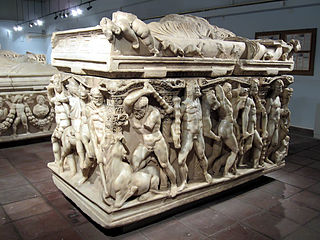
Cinna or Kinna was a town of ancient Galatia. [1] It was known as Zallara in the Hittite period. It was also the seat of a bishop; no longer a residential see, it remains a titular see of the Roman Catholic Church. [2]

Cinna or Kinna was a town of ancient Galatia. [1] It was known as Zallara in the Hittite period. It was also the seat of a bishop; no longer a residential see, it remains a titular see of the Roman Catholic Church. [2]
Its site is located near Karahamzılı, Asiatic Turkey. [3] [4] [5] The exact location of Cinna is now lost though it is thought to have been near village of Balyk Koyounji (vilayet of Angora) in a rich corn-growing area, west of Ankara. [6] [7] It is also thought to be in the locations of Cihanbeyli or Kulu. [8] [9]
During the Late Roman Empire the town was a seat of a bishop, several of whom are known to us. [10]

Tripolis on the Meander – also Neapolis, Apollonia, and Antoniopolis – was an ancient city on the borders of Phrygia, Caria and Lydia, on the northern bank of the upper course of the Maeander, and on the road leading from Sardes by Philadelphia to Laodicea ad Lycum. It was situated 20 km to the northwest of Hierapolis.
Hierocaesarea or Hierokaisareia, from the Greek for 'sacred' and the Latin for 'Caesar's', also known as Hieracome or Hierakome, was a town and bishopric in the late Roman province of Lydia, the metropolitan see of which was Sardis. It was inhabited during Hellenistic, Roman, and Byzantine times.
Savatra, Sabatra, or Soatra was a city in the Roman province of Galatia, and subsequently the Byzantine province of Lycaonia.
Nicopolis was a Roman colony in Lesser Armenia founded by Pompey in 63 BC after conquering the Kingdom of Pontus in the Third Mithridatic War. It became part of the Roman province of Armenia Prima. Today, the city of Koyulhisar in northeastern Turkey occupies the site.
Zaliche or Zaliches (Ζαλίχης) was an ancient town in the late Roman province of Helenopontus.

Tiberiopolis was a town in the Roman province of Phrygia Pacatiana, mentioned by Ptolemy, Socrates of Constantinople and Hierocles. At various times, it was considered as part of Phrygia, Isauria, and the late Roman province of Pisidia.
Temnos or Temnus was a small Greek polis (city-state) of ancient Aeolis, later incorporated in the Roman province of Asia, on the western coast of Anatolia. Its bishopric was a suffragan of Ephesus, the capital and metropolitan see of the province, and is included in the Catholic Church's list of titular sees.

Mastaura, was an ancient Greek town near Dereağzı, Nazilli in northern Caria, not to be confused with ancient Mastaura (Lycia).
Zenopolis was an ancient Roman and Byzantine city in Isauria. Its site is located near Elmayurdu in Asiatic Turkey.

The diocese of Hierapolis, was a Christian bishopric in Phrygia.
Daldis, was a town on the borders of ancient Lydia and Phrygia, a former bishopric, and is now a Latin Catholic titular see. It also minted coins in antiquity with the legend Δαλδιανων. It also bore the name Flaviocaesaria or Phlabiokaisareia, which is not attested among ancient authors but is reconstructed from epigraphic and other evidence.
Anineta, also known as Aninetum or Anineton, was a town of ancient Lydia or of Caria, and later of the Roman, and Byzantine empires, located in modern Turkey, the site of an ancient bishopric in and was an important site early in christianity. Anineta remains today a titular see of the Roman Catholic Church in the ecclesiastical province of Ephesus. In addition it minted coins bearing the legend Ἀνινησίων.

Satala or Satala in Lydia was a Roman era city and Bishopric in ancient Lydia.
Acrassus or Akrassos was an ancient Roman and Byzantine-era city in Lydia. in the Roman province of Asia and Lydia. Apparently, it is the same place that Ptolemy calls Nacrasa or Nakrasa, placed on the road from Thyatira to Pergamum.

Tabala, was a Roman and Byzantine town and a Bishopric in ancient Lydia. Tabala was on the Hermus River, and minted its own coins. It was probably mentioned by Hierocles under the name of Gabala, which is perhaps only miswritten for Tabala. It is even possible that it may be the town of Tabae or Tabai (Τάβαι), which Stephanus of Byzantium assigns to Lydia.

Sala or Salena was a town of ancient Lydia, and is a suppressed, vacant and titular see of the Roman Catholic Church.

Isauropolis was a Roman and Byzantine-era town in southern Turkey.

The Diocese of Emmaus is an ancient and titular diocese of the Roman Catholic Church, located in Emmaus/Nicopolis, Israel,. The current bishop is Giacinto-Boulos Marcuzzo who resides in Nazareth.
Aspona was an ancient city and bishopric in Galatia, in central Asia Minor. It corresponds to the modern settlement of Sarıhüyük.
Homana, also known as Homona and Homonanda, was a town of ancient Pisidia and later of Isauria and Lycaonia, inhabited in Hellenistic and Roman times. Pliny the Elder puts the town in Pisidia. It appears in the Synecdemus as part of Lycaonia under the name Umanada or Oumanada. It was the capital of the Homanadeis (Ὁμαναδεῖς), who, besides Homana, are said by Tacitus to have possessed 44 forts, a statement opposed to the remarks of Strabo, according to which the Homanades, the most barbarous of all Pisidian tribes, dwelt on the northern slope of the highest mountains without any towns or villages, living only in caves. In the reign of Augustus, the consul Quirinius compelled this little tribe, by famine, to surrender, and distributed 4000 of them as colonists among the neighbouring towns. It became a bishopric; no longer the seat of a residential bishop, it remains, under the name of Homona, a titular see of the Catholic Church.
39°13′37″N33°01′59″E / 39.226876°N 33.033014°E